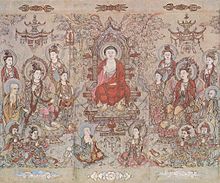

Song painting
During the Song dynasty (960–1279), landscapes of more subtle expression appeared; immeasurable distances were conveyed through the use of blurred outlines, mountain contours disappearing into the mist, and impressionistic treatment of natural phenomena. Emphasis was placed on the spiritual qualities of the painting and on the ability of the artist to reveal the inner harmony of man and nature, as perceived according to Taoist and Buddhist concepts.
Liang Kai was a Chinese painter who lived in the 13th century (Song Dynasty). He called himself "Madman Liang," and he spent his life drinking and painting. Eventually, he retired and became a Zen monk. Liang is credited with inventing the Zen school of Chinese art. Wen Tong was a painter who lived in the 11th century. He was famous for ink paintings of bamboo. He could hold two brushes in one hand and paint two different distanced bamboos simultaneously. He did not need to see the bamboo while he painted them because he had seen a lot of them.
Zhang Zeduan was a notable painter for his horizontal Along the River During Qingming Festival landscape and cityscape painting. It has been quoted as "China's Mona Lisa" and has had many well-known remakes throughout Chinese history.[2] Other famous paintings include The Night Revels of Han Xizai, originally painted by the Southern Tang artist Gu Hongzhong in the 10th century, while the well-known version of his painting is a 12th century remake of the Song Dynasty. This is a large horizontal handscroll of a domestic scene showing men of the gentry class being entertained by musicians and dancers while enjoying food, beverage, and wash basins provided by maidservants. In 2000, the modern artist Wang Qingsong created a parody of this painting with a long, horizontal photograph of people in modern clothing making similar facial expressions, poses, and hand gestures as the original painting.
 Song Dynasty ding-ware porcelain bottle with iron pigment under a transparent colorless glaze, 11th century. |  Playing Children, by Song artist Su Hanchen, c. 1150 AD. |

No comments:
Post a Comment